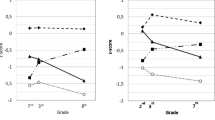Abstract
In this study, we evaluated the incidence of hyperlexia in a clinically referred sample of 80 children with developmental delays. Based on hypotheses previously formulated in the literature, the study investigated the frequency of hyperlexia among boys and girls, the incidence of hyperlexia in children with Pervasive Developmental Disorders (PDD)-spectrum compared with non-PDD diagnoses, the range of IQ and of various cognitive skills in children with and without hyperlexia, and the developmental outcomes of children with and without hyperlexia. The results revealed no significant differences in the frequency of hyperlexia in girls compared with boys. However, the frequency of hyperlexia was significantly elevated among children with PDD compared with children with non-PDD diagnoses. The range of IQ and other cognitive skills and the developmental outcomes of children with hyperlexia were comparable to those of children without hyperlexia.
Similar content being viewed by others
REFERENCES
Aram, D. M, Rose, D. F., & Horowitz, S. J. (1984). Developmental reading without meaning. In R. N. Malatesha & H. A. Whitaker (Eds.). Dyslexia: A global issue. NATO ASI Series.
Bashina, V. M. (1999). Autism v detstve [Autism in childhood]. Moskva, Russia: Meditsina.
Beery, K., & Buktenica, N. (1997). The Developmental Test of Visual-Motor Integration (VMI): 4th Edition. fhttp://www.therapybookshop.com.
Burd, L., & Kerbeshian, J. (1985). Hyperlexia and a variant of hypergraphia. Perceptual and Motor Skills, 60,940–942.
Burd, L, Fisher, W, Knowlton, D., & Kerbeshian, J. (1987). Hyperlexia: A marker for improvement in children with pervasive developmental disorder? Journal of American Academy of Child and Adolescent Psychiatry, 26, 407–412.
Burd, L, Kerbeshian, J., & Fisher, W. (1985). Inquiry into the incidence of hyperlexia in a statewide population of children with pervasive developmental disorder. Psychological Reports, 57,236–238.
Cobrinik, L. (1974). Unusual reading ability in severely disturbed children. Journal of Autism and Childhood Schizophrenia, 4, 163–175.
Dunn, L. M., & Dunn, L. M. (1981). Peabody Picture Vocabulary Test-Revised. Circle Pines, MN: American Guidance Service.
Fisher, W, Burd, L., & Kerbeshian, J. (1988). Journal of Mental Deficiency Research, 32, 357–369.
Gardner, M. F. (1990). Expressive One Word Picture Vocabulary Test-Revised. Novato, CA: Academic Therapy.
Goldberg, T. E. (1987). On hermetic reading abilities. Journal of Autism and Developmental Disorders, 17, 29–44.
Goldberg, T. E., & Rothermel. R. D. (1984). Hyperlexic children reading. Brain, 107,759–785.
Healy, J. M. (1982). The enigma of hyperlexia. Reading Research Quarterly, 17,319–338.
Healy, J. M, Aram, D. M, Horwitz, S. J., & Kessler, J. W. (1982). A study of hyperlexia. Brain and Language, 9,1–23.
Jackson, N. E. (1992). Precocious reading of English: origins, structure, and predictive significance. In P. S. Klein & A. J. Tannenbaum (Eds.). To be young and gifted (pp. 171–203). Norwood, NJ: Ablex Publishing.
Kanner, I. (1943). Autistic disturbances of affective contact. Nervous Child, 2,217–250.
Kaufman, A. S., & Kaufman, N. L. (1983). Kaufman Assessment Battery for Children. Circle Pines, MN: American Guidance Service.
Karmiloff-Smith, A. (1992). Beyond modularity: A developmental perspective on cognitive science. Cambridge, MA: MIT Press.
Leiter, R. G. (1996). Leiter International Performance Scale– Revised. Chicago: Stoelting.
Needleman, R. M. (1982). A linguistic analysis of hyperlexia. In C. Johnson (Ed.). Proceedings of the Second International Study of Child Language. Washington, DC: University Press of America.
Parker, S. W. (1919). Pseudo-latent for words. Psychology Clinics, 11, 1–7.
Paterson, S. J, Brown, J. H, Gsödl, M. K, Johnson, M. H., & Karmiloff-Smith, A. (1999). Cognitive modularity and genetic disorders. Science, 286,2221–2416.
Patti, P. J., & Lupinetti, L. (1993). Brief report: Implications of hyperlexia in an autistic savant. Journal of Autism and Developmental Disorders, 23,397–405.
Pennington, B. F, Johnson, C., & Welsh, M. C. (1987). Unexpected reading precocity in a normal preschooler: Implications for hyperlexia. Brain and Language, 30,165–180.
Phillips, A. (1930). Talented imbeciles. Psychology Clinics, 18, 246–265.
Siegel, L. S. (1984). A longitudinal study of a hyperlexic child: Hyperlexia as a language disorder. Neuropsychologia, 22,577–585.
Silberberg, N. E., & Silberberg, M. C. (1967). Hyperlexia: Specific word recognition skills in young children. Exceptional Children, 34, 41–42.
Sparrow, S, Balla, D., & Cicchetti, D. (1984). Vineland Adaptive Behavior Scales: Interview edition, survey form manual. Circle Pines, MN: American Guidance Service.
Temple, C. M., & Carney, R. (1996). Reading skills in children with Turner's syndrome: An analysis of hyperlexia. Cortex, 32, 335–345.
Tirosh, E., & Canby, J. (1993). Autism with hyperlexia: A distinct syndrome? American Journal of Mental Retardation, 98,84–92.
Volkmar, F. R, Szatmari, P., & Sparrow, S. S. (1993). Sex differences in pervasive developmental disorders. Journal of Autism and Developmental Disorders, 23,579–591.
Whitehouse, D., & Harris, J. (1984). Hyperlexia in autism. Journal of Autism and Developmental Disorders, 14,281–289.
Author information
Authors and Affiliations
Corresponding author
Rights and permissions
About this article
Cite this article
Grigorenko, E.L., Klin, A., Pauls, D.L. et al. A Descriptive Study of Hyperlexia in a Clinically Referred Sample of Children with Developmental Delays. J Autism Dev Disord 32, 3–12 (2002). https://doi.org/10.1023/A:1017995805511
Issue Date:
DOI: https://doi.org/10.1023/A:1017995805511




